Stinque Recipe Challenge
What’s better than roast chicken and mashed potatoes on a winter evening? And, of course, there are as many ways to roast a chicken as there are cooks. Here’s how I do it, and I’d like to hear how you do it – always looking for tips and tricks. First, the neck (and giblets if they’re in the cavity) go into a pot to slow cook with a rough-cut mirepoix:
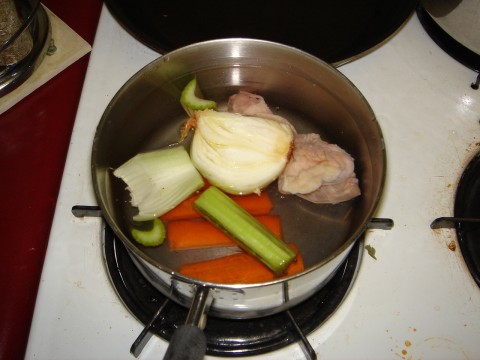
Once the chicken is done I add the pan drippings to the reduced chicken/giblets stock and whisk it with butter and flour – that gravy goes on the mashies. Now for the chicken:
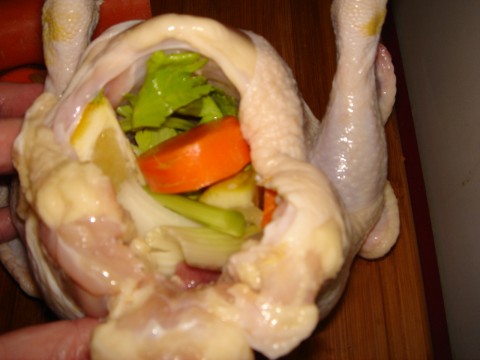
Unless I want a Perdue or kosher bird (I don’t) I’m stuck with the small organic Fairway chicken, anywhere from 3-4 pounds. I am from the 2o minutes per pound plus 10 school (then rest for at least 15 to let the juices redistribute) but I will assure it’s done by making sure the breast is at least 160 F.
First, wash the chicken and dry it thoroughly. Salt and pepper in the cavity at this point, and you don’t have to, but I’ll usually stuff the cavity with 2 lemon quarters, and rough-cut carrots, celery, onions or leeks, and a sprig to two of fresh thyme if I have it. If you don’t stuff it the bird will cook more quickly. Also, especially for a small chicken, I’m not a big advocate of trussing because the wings will be mostly inedible anyway – sufficient to tuck them under the bird. Here I trussed the legs simply to keep the veggies in:
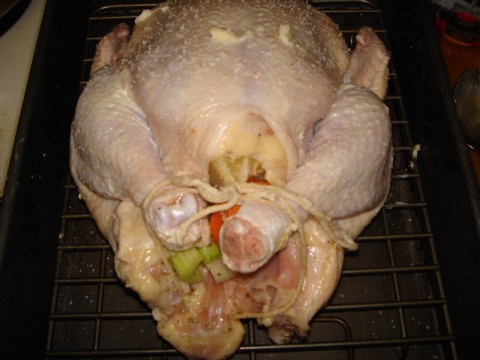
At this point you can go all Gordon Ramsay and put butter or chive butter or truffle butter or whatever under the skin, but I have a life outside my tiny kitchen. It’s sufficient unless it’s an occasion to butter the outside of the bird and salt it – no pepper because the high heat of the initial blast in the oven will cause it to taste bitter.
It’s important to get heat under the bird so it cooks evenly, so cook it on a rack or, ideally, in a V-rack. An initial blast of heat at 475F is also important as it crisps the skin, and let’s face it, the skin is the best part of the chicken. After 15-20 minutes at 475, depending on the size of the bird, lower the heat to 350 and cook for 20 minutes per pound, then 10 more minutes, checking the breast temperature before you put it in for the last 10. Here the temperature was 170 plus after 75 minutes total for a 3.25 pound bird, so I declared it done.
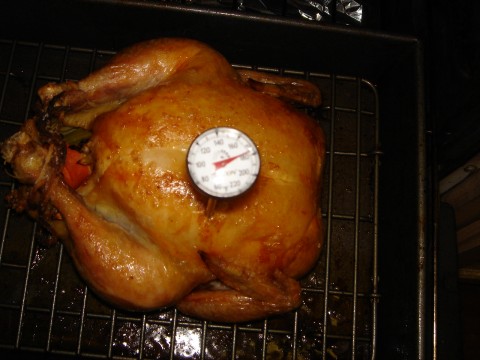
Cover the bird with aluminum foil and rest it for at least 10 minutes to let the juices redistribute.
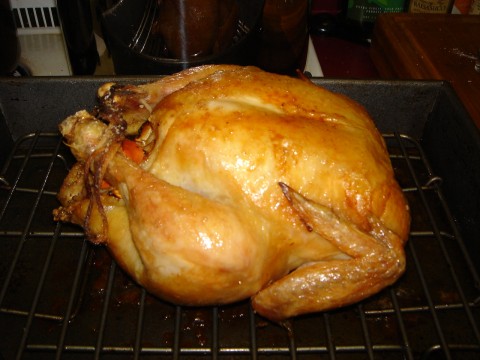
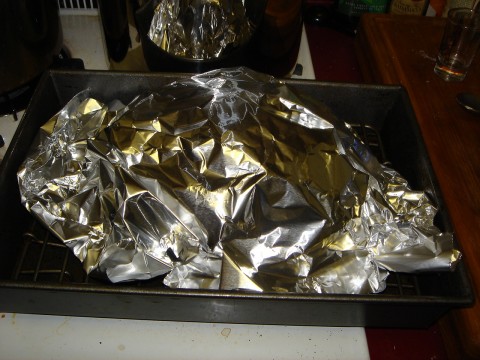
There’s no point in making a chicken if you toss the pan drippings. Skim the fat if you wish, but don’t lose the chance to make great gravy for mashies or rice. I reduce the broth from the neck and giblets (see above), fortify with canned stock if necessary, salt and pepper to taste, and whisk with butter and flour to thicken.
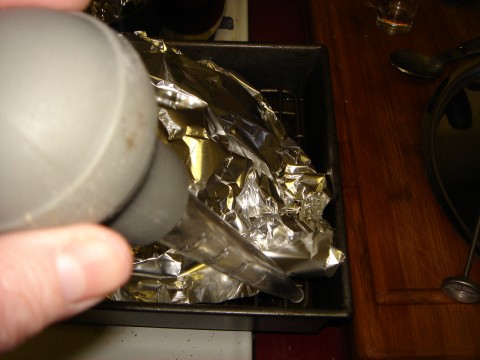
I use about 2 tablespoons of butter and 1 tablespoon of flour to thicken the gravy, but it’s easy to estimate – if you get it too thick, just add water and keep whisking.
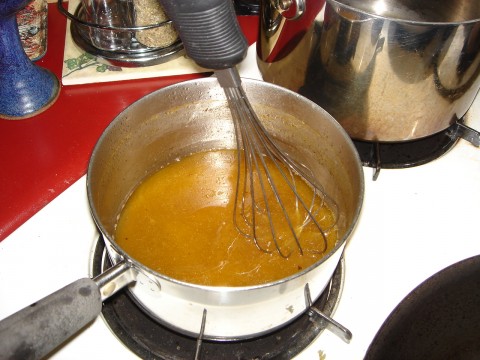
So that’s my method – what’s yours? And if you’re interested, there’s another cook who has her own views on the subject:
Oh, man, I love roast chicken. It’s been a while since I made one, though, rather than just bringing it home from the supermarket already roasted. Will have to try it again.
@Serolf Divad: Fairway, my grocery store, has great roast chickens. The GF always yells at me to get one to save time, then remembers why I do them from scratch once it’s done. No gravy from a can in this apartment, so if a bird doesn’t produce, it does not get in the door.
@blogenfreude:
Why don’t you want a Kosher bird? Just curious. I’ve had Kosher chicken and it seemed okay (but then again I didn’t make it.)
My approach is to use two lemons and 4 or 5 cloves of garlic. Slice the lemons and four of the garlic cloves, place in the cavity, save four slices of lemon. Grease up the bird with extra virgin olive oil, slide the four slices under the skin (two on each side), and crush the last clove or two, and smear under the skin as a paste. Cover the outside of the bird with a sprinkling of kosher salt and cracked black pepper, and cook it in an already hot oven at 350 for 20 minutes a pound. Do a blast searing for a few minutes at the end to crisp the skin, then pull out and let it rest.
My favorite chicken dish, however, is pollo ezechiele (Ezekial’s chicken), an Italian Jewish recipe. So flipping easy to make, too. The measurements are rough guides, if you like or don’t like olives or garlic, adjust accordingly:
3-4 lb fryer chicken cut into serving pieces (or 3-4 lbs of breasts and thighs, if you don’t like cutting up a whole chicken)
olive oil
black pepper and salt to taste
1/2 cup assorted olives (black kalmata are usually what I use) pitted and coarsely chopped
4 garlic cloves, minced
2 large tomatoes, peeled, seeded, and chopped (when tomatoes aren’t in season, just use canned tomatoes)
1 tbsp chopped fresh basil
1 tbsp chopped fresh rosemary
1 tbsp chopped sage
1/2 cup dry red wine
Sprinkle chicken pieces with pepper and salt (use less salt than you otherwise would, because the olives will add brine). Warm olive oil in a large saute pan over high heat. Add chicken and saute until golden on all sides. Add olives, garlic, tomatoes, and herbs. Cover, reduce heat to low and simmer and stir occasionally until the chicken is tender, about 20 minutes. Uncover, add the red wine, raise heat to high and stir, reducing the pan juices. Transfer to warm plate, sprinkle more fresh herbs, cracked black pepper, and Parmesan cheese to taste. Can serve over brown rice, or alone.
@SanFranLefty: Damn – now you give me another cooking assignment … and calamata olives in oil? The best!
@SanFranLefty: And if it’s Italian/Jewish I’d serve it over basmati rice, for balance.
@blogenfreude: Sometimes I’ll slice up a two-day old semi-stale baguette and toast them. Put the chicken and sauce over the toasted slices, and they absorb the liquid and thicken things up.
This bakery is across the street from my building, so there’s a stale baguette within reach at home most days.
@blogenfreude: We haven’t had many stale baguettes around the house lately because we’ve been making this cioppino from the central coast on an almost weekly basis, with the addition of meat from a Dungeness crab and a dollop of my new crack, Silafunghi hot chili sauce from Italy.
You’ve got the vegetarians drooling. Excellent. I have one word for you: capon.
It makes an ideal bird for Xmas: not too much of it. Plus it’s juicy and flavorful. Following your method above it would be delicious.
I have one suggestion (uh oh) from my days as a cook/Richard Olney (the most original writer on the subject of food and how to cook it as if you’d been born in Arles after Elizabeth David) fanboy. You’re spot on with the resting period. I might have allowed more but whatever. It’s what changes hot seared meat to scrumptious deliciousness – as the actress said to the bishop. Deglaze the pan with wine, or sherry, madeira, gin (don’t knock it, bitch), whatever. Now, instead of thickening with a roux try this: chill a stick of best quality Normandy unsalted butter. Hello, Zabar’s! Cut into very small dice. When your pan is deglazed and fortified, bring the juices to a point under boiling. Now, as you carve the bird, at the last minute, whisk into your gravy the chilled butter bits. DO NOT LET THE SAUCE RETURN TO THE BOIL. It will mount into a sumptuous sauce that will make you want to lie down on the parquet to experience life being lived. This is a great technique that separates restaurant cooking (nothing wrong with that, Patrick) from home style fabulosity. Try it.
When I cooked in London I liked to serve poussin (cornish hen) split down the back, the backbone removed, the breast stuffed with butter mashed into finely chopped spinach, and skewered with two skewers making an X-shape. Then see above re resting, deglazing, butter finish.
But kudos, my man, for bringing butch back to the kitchen. I tried but failed for obvious reasons.
@SanFranLefty: So now I have to order that hot sauce – to this point, the hot sauce du jour has been the stuff that the GF brings when she hits a particular restaurant in Kyoto. You have to buy a meal to buy the hot sauce. It’s light, heat builds nicely, and the peppers in it crunch a bit, like dried onions. Can’t really describe it …
@ManchuCandidate: Kosher is cool if you like brined chicken and you care about how the animal died. The thing I’ve found is that while I brine chicken and turkey before I roast them, kosher birds seem to be a little too salty for my taste. Some people brine in sugar water, blah de blah. When I find an unconflagrated megabus to Canadialand, I’ll make you Bubbe-approved chicken soup and soul food. You buy the beer.
@blogenfreude: So far as I know, the only US distributor of Silafunghi is Michael Ciarello (sp?) and the Napa Style store he owns adjacent to his heavenly Bottega restaurant in Yountville. There’s a few chi-chi markets in SF that sell Silafunghi, but I think they buy it through Napa Style and then mark it up. Unless you or someone you know is going to Italy, the best option is to order it though Napa Style. If it’s available, buy some, because it’s either the village in Italy runs out of peppers or they go on vacation, but about three months of the year it’s on back order. We have three unopened bottles in the cabinet. The shit is amazing with about half a teaspoon mixed in with tomato sauce for a simple Tuesday night pasta. Holy shite.
NOJO • Nightmare at the Museum From the last time he threatened to bomb Iran, 2020. Remember that one? All a misty blur now.
NOJO • TRUMP TARIFFS UNLEASHING FURY OF CANADIANS - AND THEIR LEGENDARY SNIPERS! @ManchuCandidate: I have birthright citizenship in Cascadia, so I think I’m good.
MANCHUCANDIDATE • TRUMP TARIFFS UNLEASHING FURY OF CANADIANS - AND THEIR LEGENDARY SNIPERS! @nojo: Only the sane parts... like the West coast, New England (minus the Bruins and…
NOJO • TRUMP TARIFFS UNLEASHING FURY OF CANADIANS - AND THEIR LEGENDARY SNIPERS! @ManchuCandidate: So, can you guys annex us now?
MANCHUCANDIDATE • TRUMP TARIFFS UNLEASHING FURY OF CANADIANS - AND THEIR LEGENDARY SNIPERS! PP is done. 51st state, my ass.
NOJO • TRUMP TARIFFS UNLEASHING FURY OF CANADIANS - AND THEIR LEGENDARY SNIPERS! @FlyingChainSaw: No, but my government was.
FLYINGCHAINSAW • TRUMP TARIFFS UNLEASHING FURY OF CANADIANS - AND THEIR LEGENDARY SNIPERS! @nojo: Were you kidnapped?
NOJO • TRUMP TARIFFS UNLEASHING FURY OF CANADIANS - AND THEIR LEGENDARY SNIPERS! @FlyingChainSaw: I’ve spent the past five weeks looking like Astronaut Dave going through the…
FLYINGCHAINSAW • TRUMP TARIFFS UNLEASHING FURY OF CANADIANS - AND THEIR LEGENDARY SNIPERS! NOJO - HOW COME WE'RE NOT COVERING KRASNOV?
NOJO • The Reckoning Four years later: Uhhh, how’d that work out?